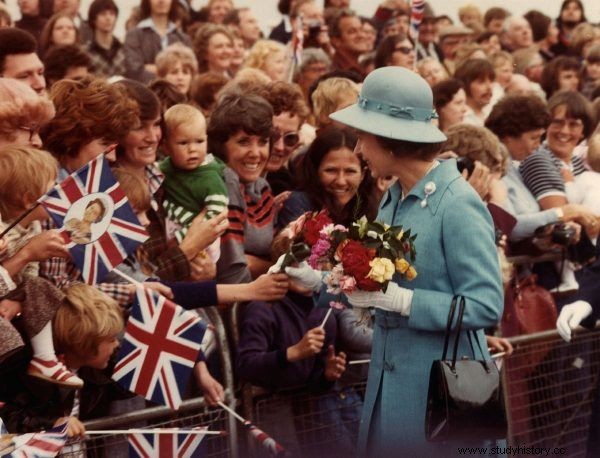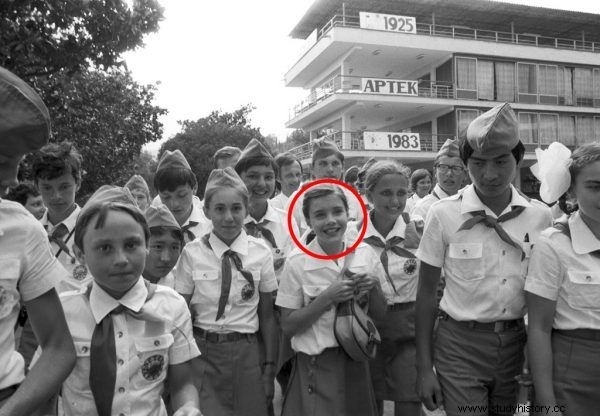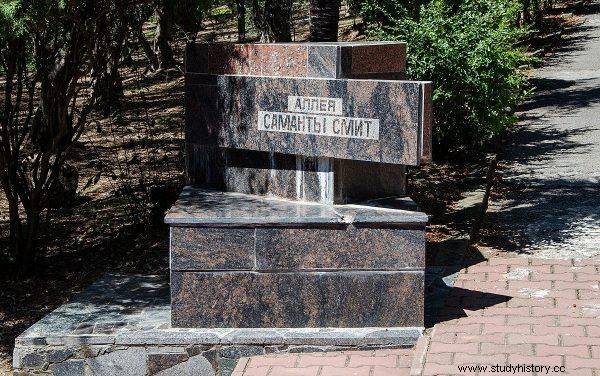How to find out if war is about to break out? One little American girl decided to ask at the source. Her letter to the Soviet leader made her a symbol of the struggle for peace. He was also welcomed in the USSR:its initiative was carefully used by communist PR specialists.
"I asked my mother if war would break out" - this is how teenage Samantha Smith from Manchester, Maine recalled the moment that - as it turned out later - influenced her further fate.
In November 1982, such a question was by no means unreasonable. It seemed that another global conflict was about to break out at any moment. And it was realized that this would be an atomic war. One that neither side wins and that turns Earth into a desert.
Answering Samantha's question, her mother showed her the cover of Time magazine, which featured the face of the new Soviet first secretary, Yuri Andropov. Quite right:Brezhnev's successor, the old Kagébist, was indeed one of the few people in the world who could either escalate the conflict or ease tension.

Samantha Smith was a very resolute little girl. She already had a letter to Elizabeth II herself. The photo shows the Queen during her visit to Washington in 1977.
The resolute ten-year-old did not consider this answer sufficient. "If everyone is so afraid, why doesn't anyone ask him if he is going to start a war?" She asked. And her mother encouraged her, " Why don't you write to him yourself? ". The girl took this suggestion deadly seriously. She already had a letter to the British Queen Elizabeth II on her account. But even she did not expect the storm to create.
Reply from Moscow
To everyone's surprise, Samantha's letter was published by the Soviet newspaper Pravda. Soon after, in the spring of 1983, the girl received an answer from Andropov himself. The Soviet leader wrote back that he did not intend to conquer the USA at all. He recalled that during World War II, both countries fought side by side against the Germans. He also showed off his acquaintance with Mark Twain's "The Adventures of Tom Sawyer", comparing Samantha to the book Becky - a talented and enterprising student who quickly won the hero's heart.
Using the letter as a field to promote the Soviet Union, Andropov did not fail to mention how pacifist the views of Comrade Lenin and all Soviet workers and peasants were. Nuclear weapons are terrible, he added, and that it would be best to simply destroy them. Finally, he encouraged Samantha to come to the USSR on her own in the summer, meet the children there and meet the charms of Soviet life.
The letter from the first secretary was obviously a piece of good PR work. It was not sent in vain, only a few months after a spontaneous message from a little American woman. With skilful emphasis, it looked like a hand outstretched for international reconciliation. The invitation to the picturesque Artek pioneer camp in Crimea seemed especially cordial. Even if at the same time that Andropov sent them, political prisoners of the communists were still rotting in completely different Soviet "camps" .
The media, however, picked up on Andropov's conciliatory tone, and Samantha immediately became a star. It found its way into the columns of American newspapers and television programs. And she actually visited the USSR. She became friends with Soviet peers, got calls from Andropov and Valentina Tereshkova, the first woman in space.
War or peace?
Despite the assurances of the Soviet First Secretary, the war was in the balance. It almost did not explode in September of the same, 1983 - and it happened by accident! Early warning computers from the Sierpukhov-15 command center near Moscow sent signals about several American missiles allegedly heading towards the USSR . Fortunately, the officer, Stanisław Petrov, who picked them up, decided to ignore them. According to procedures, he should report the attack to headquarters. This would activate the entire Soviet arsenal and lead to retaliation against the US.
Petrov guessed that the alleged signals were simply a system error. After all, who would start a nuclear war with just a few missiles when both powers had thousands in their arsenals? In addition, both countries have recently tried to talk to each other. One of the proofs was the case of teenage Samantha.

Samantha Smith during his visit to the USSR in 1983 at the Artek pioneer camp.
Petrov probably was not aware of this, but the American, encouraged by the success of her letter, came up with another original idea. She proposed that the two superpowers should swap ... grandchildren of the leaders . Such voluntary "hostages" would discourage hawks on both sides from making hasty decisions.
Not all Americans were enthusiastic about Samantha and her family. Some, doubtful, saw the little girl at best as a "useful idiot" used by the Kremlin. Others saw it as a "fifth column" of the USSR. Most, however, adored her and welcomed her presence in the media. That's probably why thirteen-year-old Samantha was invited to, for example, participate in the television series "Lime Street".
Unfortunately, it was the popularity that indirectly contributed to the girl's death. A disaster struck when she was returning from a movie set in a small business plane on August 25, 1985. On a rainy night, the machine crashed among the trees. All crew and passengers died - including Samantha and her accompanying father.

Samantha Smith Memorial Avenue in Artek.
Memory and disinformation
The tragedy caused a great stir. The family received condolences from the heads of both superpowers. At the same time, however, there were rumors that Samantha's death may not have been the result of an accident . The coup was even suggested between the lines by the Soviet news agency, TASS. Thanks to these promptings, the inhabitants of the USSR could conclude that the girl had been silenced forever by the American CIA. All this to continue President Ronald Reagan's tough line against Moscow without any obstacles.
As reported in the American press, in the USSR, attempts were made to blame anti-Soviet journalists for the "attack". Charges were made, inter alia, of Vladimir Bukowski, deported from the USSR, and of the American-Israeli rabbi Meir Kahane. But also on the other side of the globe, developments were followed.
Recently declassified materials from the CIA show that the agency was closely taking note of Soviet suggestions. For example, the alleged "attack" on Samantha Smith was mentioned in one of the reports on Soviet disinformation activities. He was mentioned in line with the deaths of Swedish Prime Minister Olof Palma and Maurice Bishop of Granada.

The alleged attack on Samantha Smith in one of the CIA documents was placed in line with the murder of former Swedish Prime Minister Olof Palme (shown in the photo from 1968).
Despite lingering suspicions, there is no evidence that the death of the teenage "peace ambassador" was more than an accident. But it must also be admitted that the catastrophe would not have happened had it not been for the activities and popularity of the girl. If little Samantha did save the world from destruction, she paid the highest price for it. She left her articles, photos, stamps and names. The memory of the already forgotten heroine is also maintained by the website www.samanthasmith.info.
